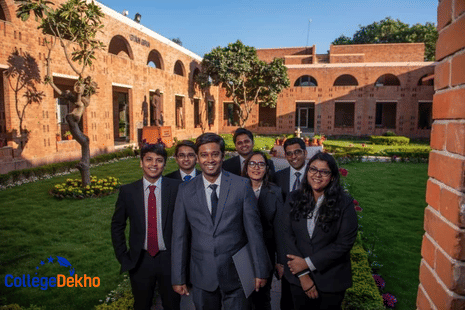
An Executive MBA (EMBA) is an important economic investment, and with foreseeable financial management planning centred on scholarship, educational loans, and the calculation of payback (ROI), candidates can make this life-changing educational opportunity affordable and valuable. This is how you can develop a powerful financial plan to pursue your Executive MBA 2026.
Also Check -
Who Should Choose an Executive MBA Over a Traditional MBA?
Understanding Total Costs of Pursuing an Executive MBA
The total cost of an Executive MBA is not only the tuition fee, but also accommodation, study materials, travelling (where applicable to global immersion schools), and living costs as an incidental cost. The best Executive MBA programs in India and globally can be priced at as low as INR 10 lakhs and up to INR 40 lakhs, with international colleges going beyond 50,000 dollars annually. When your financial planning is early, you can use published program budgets to estimate how much money you will spend.
Scholarships for Executive MBA: Reducing the Burden
Most leading B-schools and universities offer scholarships for Executive MBA candidates based on merit, diversity, industry background, or need. Check different types of scholarships that can help you reduce your financial burden to pursue an Executive MBA below:
Merit-Based Scholarships: Awarded to top performers in academics, professional achievements, or entrance exams.
Need-Based Scholarships: Available for candidates who demonstrate financial need, sometimes covering a portion or full tuition.
Diversity & Leadership Fellowships: Offered to encourage participation from underrepresented groups, women leaders, or short-supply industries.
Corporate Sponsorships: Some organisations sponsor all or part of the Executive MBA fee for high-potential employees as a leadership investment.
Every B-school releases the details about the scholarship programmes offered by them for the students. You can go through these details on their website or brochure to get a scholarship and reduce your financial burden.
Also Check -
Why Startup Founders Should Consider an Executive MBA
Educational Loans for Executive MBA
Banks and financial institutions in India and internationally offer education loans tailored for Executive MBA seekers. Check the types of loans that you can apply to pursue an Executive MBA
Secured Education Loans: Require collateral and may offer lower interest rates (ranging from 7 per cent–10 per cent p.a.).
Unsecured Education Loans: No collateral, often slightly higher interest, and quicker disbursal.
Moratorium Period: Many lenders offer a 6 to 12 month grace period after graduation before EMI repayment begins, making it easier to manage cash flow during studies.
Repayment Tenure: Education loans generally provide 5 to 10 year repayment options, keeping monthly EMI manageable.
Comparison of EMI calculators, processing charges, margin money, lender reputation and early repayment terms needs to be completed before completing a loan. Now, the digital loan aggregators provide speedy eligibility checks and document upload systems.
Planning for ROI after an Executive MBA
ROI (Return on Investment) is a key factor in EMBA financial planning. Analyse expected career progression, salary growth, placement statistics, and networking dividends post-MBA.
Short-Term ROI: Average Executive MBA graduates from reputable programs see a salary surge between 30 to 100 per cent within 2 to 3 years. Calculate the time it will take to recover your total investment from net salary hikes and bonuses.
Long-Term ROI: Alumni networks, global exposure, leadership skills, and business credibility acquired from an Executive MBA provide enduring returns well beyond immediate pay rises.
Intangible ROI: Consider broader benefits such as confidence, entrepreneurial exposure, personal growth, and higher chances of international opportunities.
Also Check - Best Executive MBA Programs for Working Professionals
Smart Saving and Budgeting Tips for an EMBA
Check the smart and budgeting tips for the Executive MBA below:
Start Early: Set aside savings even before you apply to buffer against unexpected costs.
Budget Carefully : Account for entrance test fees, application charges, laptop, travel, and health insurance.
Part-Time Work or Consulting: Some Executive MBA programs allow flexible work during study; explore freelance or part-time roles to maintain income flow.
Tax Benefits: In many countries, a percentage of tuition and interest paid on education loans is tax-deductible; consult a financial advisor for tailored guidance.
Breaking down your graduate school plan (Executive MBA) with a plan to invest in your school (scholarships) and student loans (smart borrowing) and reviewing returns on investment (ROI) can make an otherwise costly dream a strategic, well-manageable investment. Do the research as early as you can, use everything possible and remember, the financial discipline you learn now will be your greatest helper when you take a confident stride into the next stage of your international leadership career.
Related Articles
| Essential Skills to Develop Before Starting an Executive MBA | Is an Executive MBA More Valuable Than a Traditional MBA for Career Growth? |
|---|
If you have any queries, check out the QnA Zone . For help regarding admissions, fill out the Common Application Form (CAF) or call our helpline number 18005729877. Stay tuned to CollegeDekho for more updates!
Are you feeling lost and unsure about what career path to take after completing 12th standard?
Say goodbye to confusion and hello to a bright future!

FAQs
Yes, flexible executive MBA programs often allow students to work part-time during studies, which can help offset costs, but it’s essential to balance academic workload and earning potential
Factor in opportunity cost (lost income during study), projected salary increases post-MBA, industry benchmarks, and long-term career goals to evaluate the return on your investment; research typical post-EMBA earning potential for your sector.
Employer sponsorship usually covers tuition and may also include travel costs or leave for study, but it generally requires students to demonstrate the benefit to their organisation and may involve a service bond or agreement.
Students can finance their executive MBA through scholarships, employer sponsorship, educational loans, deferred payment plans, or personal savings; many programs offer dedicated financial aid resources for applicants.
The total cost of an Executive MBA program includes tuition, travel, accommodation, textbooks, and expenses for networking events or extracurricular activities, with significant variation based on the institution and location.
Was this article helpful?





















Similar Articles
How to Prepare for B-School Interviews After Scoring High in CAT
Last One Month CMAT 2026 Preparation Tips
MAH MBA CET Cutoff 2026 for JBIMS: Check Category-wise Expected and Previous Year Cutoff
Mistakes to Avoid on SNAP 2025 Exam Day
SNAP 2025 Last Minute Tips - Check What to Do in Last Few Days of SNAP Preparation
SNAP 2025 Exam Day Guidelines: Documents to Carry, Instructions, Things to Avoid